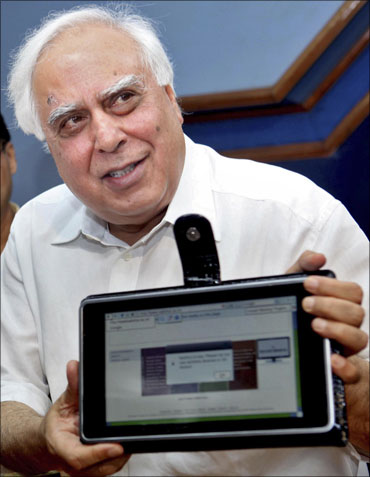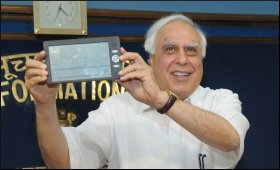DesiGuy
SENIOR MEMBER

- Joined
- Jul 27, 2009
- Messages
- 4,138
- Reaction score
- -3
- Country
- Location
The week began with a great story. The Indian government was going to build a $20 (or maybe even $10) laptop, finally bringing cheap computing to the masses, in a manner which had eluded projects like One Laptop Per Child.
The only problem was that the "$20 laptop" turned out to be no such thing - it's not a laptop and it's not clear exactly what it is, when it will appear or what it wil cost. But the world's technology journalists fell for the story - along with the BBC - so how did that happen?
Financial Times articleIt was all triggered by an article in the Financial Times on Monday. This claimed that the device would be launched at an education event on Tuesday, and compared the $20 laptop to India's $2000 car - although that too has so far failed to appear, some years after it was promised. The FT's article went round the world at the speed of light, and my editors - and I suspect others - were soon asking why we hadn't got the story.
But on the Tuesday, when the press conference happened in the town of Tirupati, the miracle gizmo turned out to be a prototype of a handheld device, rather than a laptop. The aim of the device, under development by local universities, was to use technology to bring education to millions of new students across India.
And the price? Well, that was pretty unclear. It might be $20, it might be $10, depending on production volumes, and presumably the level of government subsidy. The only photo to have emerged appears to show a solid white rectangular object, without a display or a keyboard.
I've spoken to the author of the FT article, James Lamont, who told me that reports about a laptop had actually surfaced first in the Indian press last week after a briefing by the Ministry of Human Resource Development. It appears that the ministry official, perhaps not technically aware, used the word laptop in that briefing to describe an e-learning device.
That was enough to turn an interesting educational initiative by the Indian government into a story that sparked worldwide interest amongst the techie community. Now it has turned out to be less than it appeared, many of my fellow journalists and bloggers have reacted with contempt. Engadget talked of "purposeful misinformation" by politicians seeking re-election, while the Times of India quoted a university researcher as saying "The entire world was watching. This act.....has shamed the nation."
But perhaps this is a little unfair. The Indian government, James Lamont told me, is faced with a massive educational challenge, needing to create as many as 1500 new universities over the next six years. It seems to be deadly serious about using technology to bridge its educational gap.
The price of computing is coming down - though $20 seems a bit of a stretch, with component makers rushing to explain that you won't even get a screen for that price. And aren't we getting hung up on the idea of a laptop? It is mobile phones that are really proving to be the transformational technology in developing countries. If Indian researchers can come up with a $20 mobile internet device to put millions of students online, then they really will deserve global headlines.
BBC - dot.life: What happened to the $20 laptop?
P.S. (It's a BLOG, So you people have the option to agree or disagree).
The only problem was that the "$20 laptop" turned out to be no such thing - it's not a laptop and it's not clear exactly what it is, when it will appear or what it wil cost. But the world's technology journalists fell for the story - along with the BBC - so how did that happen?
Financial Times articleIt was all triggered by an article in the Financial Times on Monday. This claimed that the device would be launched at an education event on Tuesday, and compared the $20 laptop to India's $2000 car - although that too has so far failed to appear, some years after it was promised. The FT's article went round the world at the speed of light, and my editors - and I suspect others - were soon asking why we hadn't got the story.
But on the Tuesday, when the press conference happened in the town of Tirupati, the miracle gizmo turned out to be a prototype of a handheld device, rather than a laptop. The aim of the device, under development by local universities, was to use technology to bring education to millions of new students across India.
And the price? Well, that was pretty unclear. It might be $20, it might be $10, depending on production volumes, and presumably the level of government subsidy. The only photo to have emerged appears to show a solid white rectangular object, without a display or a keyboard.
I've spoken to the author of the FT article, James Lamont, who told me that reports about a laptop had actually surfaced first in the Indian press last week after a briefing by the Ministry of Human Resource Development. It appears that the ministry official, perhaps not technically aware, used the word laptop in that briefing to describe an e-learning device.
That was enough to turn an interesting educational initiative by the Indian government into a story that sparked worldwide interest amongst the techie community. Now it has turned out to be less than it appeared, many of my fellow journalists and bloggers have reacted with contempt. Engadget talked of "purposeful misinformation" by politicians seeking re-election, while the Times of India quoted a university researcher as saying "The entire world was watching. This act.....has shamed the nation."
But perhaps this is a little unfair. The Indian government, James Lamont told me, is faced with a massive educational challenge, needing to create as many as 1500 new universities over the next six years. It seems to be deadly serious about using technology to bridge its educational gap.
The price of computing is coming down - though $20 seems a bit of a stretch, with component makers rushing to explain that you won't even get a screen for that price. And aren't we getting hung up on the idea of a laptop? It is mobile phones that are really proving to be the transformational technology in developing countries. If Indian researchers can come up with a $20 mobile internet device to put millions of students online, then they really will deserve global headlines.
BBC - dot.life: What happened to the $20 laptop?
P.S. (It's a BLOG, So you people have the option to agree or disagree).













